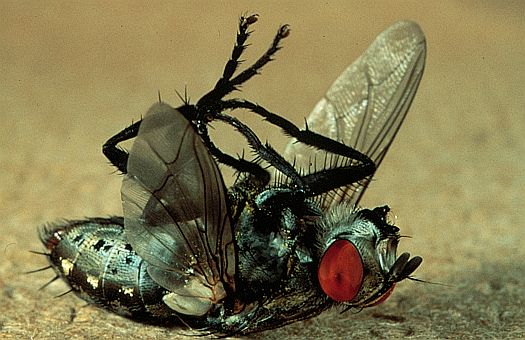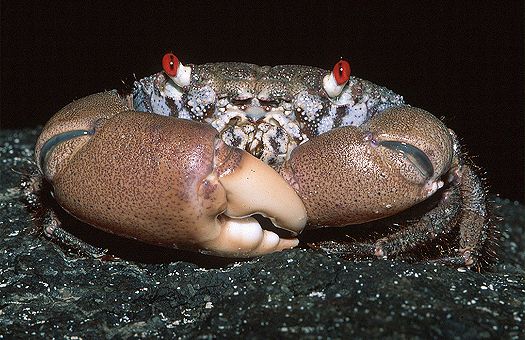
- by Gregor Bucher - Tribolium castaneum and Drosophila melanogaster adults (darkfield illumination)

 The Fly / Fly II
The Fly / Fly II
Varese Sarabande 302 066 688 2
Released on October 18, 2005

 home
home Spider
Spider
Virgin Records/EMI (FR) 72435 825712 8
Released on November 12, 2002
[OUT OF PRINT]










Filter flies. Moth flies, drain flies or filter flies belong to the family Psychodidae. These small, dark flies are about 1/8 inch long with wings covered by tiny hairs and held in rooflike fashion over the body. Filter flies have long, drooping antennae. Larvae live in the gelatinous material in sink drain traps and sewers. Where sinks regularly overflow, these flies build up in the overflow pipe. When drain traps of sinks, commodes and floor drains dry out, large numbers can enter dwellings from the sewer. Ou seja, no caninho da pia meu camarada! Elas estão em todos os nossos banheiros, 87%. As pessoas querem matar elas por causa da bronquite


Playing at My Vise - Tying Flies

While lazily fly fishing for bluegills this summer I watched hungry fish tracing the movements of flies buzzing over the water. It was truly comical watching fish swim around and around in tightening circles, but persistence paid off, because the instant a fly would land on the edge of a leaf, bam! it was inhaled. Remarkably, these were not mayflies or other aquatic varieties; instead, they were insects similar to common houseflies. Then it struck me, I'd been tying flies for over ten years, and had yet to tie a "fly." So, last weekend I decided to spend an afternoon doing just that, tie some flies, and attempted something more realistic as opposed to impressionistic. The resulting flies will likely find a home in my realistic display, presented as food for other larger critters, instead of being cast towards bluegills. I tied six flies that day; each a little bit different and photos were taken during the first attempt, which are presented below.

- by Andreas Berghammer - Expression of green fluorescent protein in the eyes of transgenic beetles (top two animals, the beetle below is wild type) ...click on image for next picture...
Fleas
 Fleas are among the top economic pests in the U.S. Each year 52 million pet owners nationwide spend nearly $500 million on flea control. While killing adult fleas to provide quick relief is a good start, a long term solution is more desirable as adult fleas comprise only 5% of the flea population, eggs comprise 50%, larvae comprise 35%, and pupae comprise 10%. Fleas are among the top economic pests in the U.S. Each year 52 million pet owners nationwide spend nearly $500 million on flea control. While killing adult fleas to provide quick relief is a good start, a long term solution is more desirable as adult fleas comprise only 5% of the flea population, eggs comprise 50%, larvae comprise 35%, and pupae comprise 10%.

I decided to try using a size 18 curved scud hook to achieve some curvature to the fly’s body shape, and laid down a base layer of 10/0 thread. 
The next step was to fashion some eyes, red ones, similar to the flies encountered on the water. My first experiment was rather unsuccessful, trying to roll red feather fibers into balls, suitable for wrapping in fine mesh. 
I found it much faster and easier to grab two red glass beads in the mesh and used that method instead. I need to mention that smaller seed beads were used on my next attempts, along with finer organza mesh. 
A single piece of mesh was used to grab and hold both beads, which were then tied onto the hook, with figure eight wraps of thread between the eyes to separate them. 
To create the abdomen a green peacock body feather and a strip of foam were used. The underside of the feather was wiped with Flexament, tinted green, and the foam was quickly wiped with a green marker pen before securing onto the hook. The feather was tied down at the tips, and then the foam was added. 
The foam and feather were pulled forward and the segmenting began. Three wraps of thread over the top of the feather, then a couple of wraps underneath progressing forward, then three more over the top, until the abdomen was completed. The excess feather and foam was trimmed away with fine-tipped scissors. (White thread was used to make it more visible in these photos, and was later colored with a permanent marker.) 
Making legs was challenging, basically because they are so small. Single black bristles from a small hand broom were used as well as the smallest feathers I had, from the neck of a Starling. First step is wrap some thread onto the leg material, and then tie Starling feather tips onto the bristles. 
The legs were held along the side of the fly, and secured to the hook. After each leg was secured, the thread was cut and used for making and tying additional legs. 
A set of realistic wings are tyed onto the fly 
Once both wings were secured to the hook with thread, a second starling neck feather and peacock body feather were tied down at the tips, directly behind the eyes. The wings are lifted up and away from the body making it easier to get the final segmentation wrap behind the wings, with peacock covering the wing tie-in points. 
A drop of Flexament was placed between the eyes, and after drying, was touched with a black marker. 
I really had a lot of fun tying this fly, and now have visions of holding it just above the waters surface, swinging around and around, trying to make the bluegills dizzy. |
My latest realistic house fly is pictured below, and will be used in the movie,
Thats why the hook has been cut off...

Tirada em (Consulte mais fotos aqui)
A tiny insect measuring about 5mm in length and 3mm in width. This was constantly on the move. Luckily I got 1 clean shot.

Realistic house fly 
To be used as a studio prop for a movie, so the hook had to be cut off... 


I tyed a dozen of these flies, here's one more  Art Flies Page
Art Flies Page





 The Fly / Fly II
The Fly / Fly II 













 Spider
Spider 












































 There are 15,000 described species of ants. 15% live in Australia.
There are 15,000 described species of ants. 15% live in Australia. 










 Fleas are among the top economic pests in the U.S. Each year 52 million pet owners nationwide spend nearly $500 million on flea control. While killing adult fleas to provide quick relief is a good start, a long term solution is more desirable as adult fleas comprise only 5% of the flea population, eggs comprise 50%, larvae comprise 35%, and pupae comprise 10%.
Fleas are among the top economic pests in the U.S. Each year 52 million pet owners nationwide spend nearly $500 million on flea control. While killing adult fleas to provide quick relief is a good start, a long term solution is more desirable as adult fleas comprise only 5% of the flea population, eggs comprise 50%, larvae comprise 35%, and pupae comprise 10%.











কোন মন্তব্য নেই:
একটি মন্তব্য পোস্ট করুন